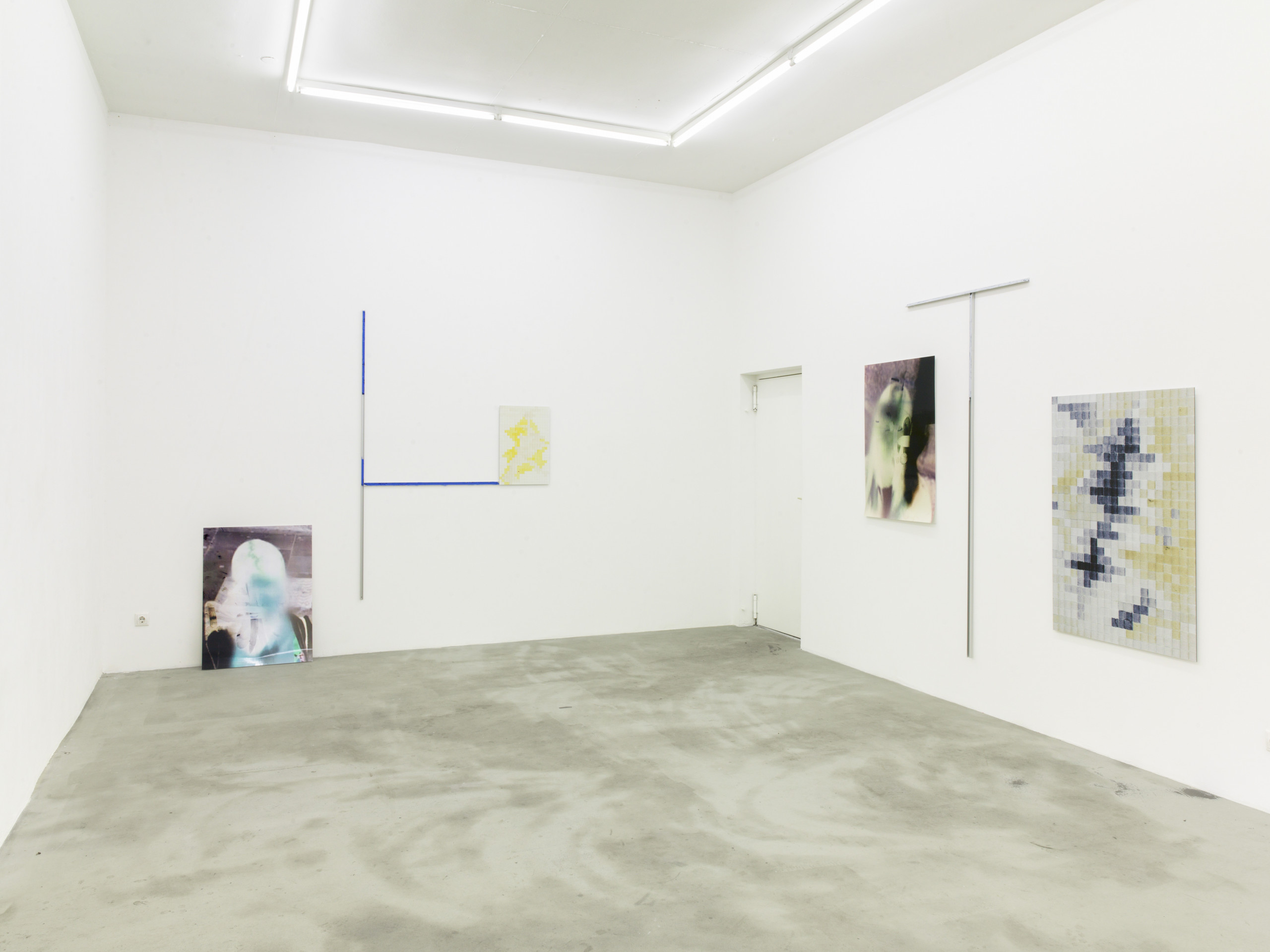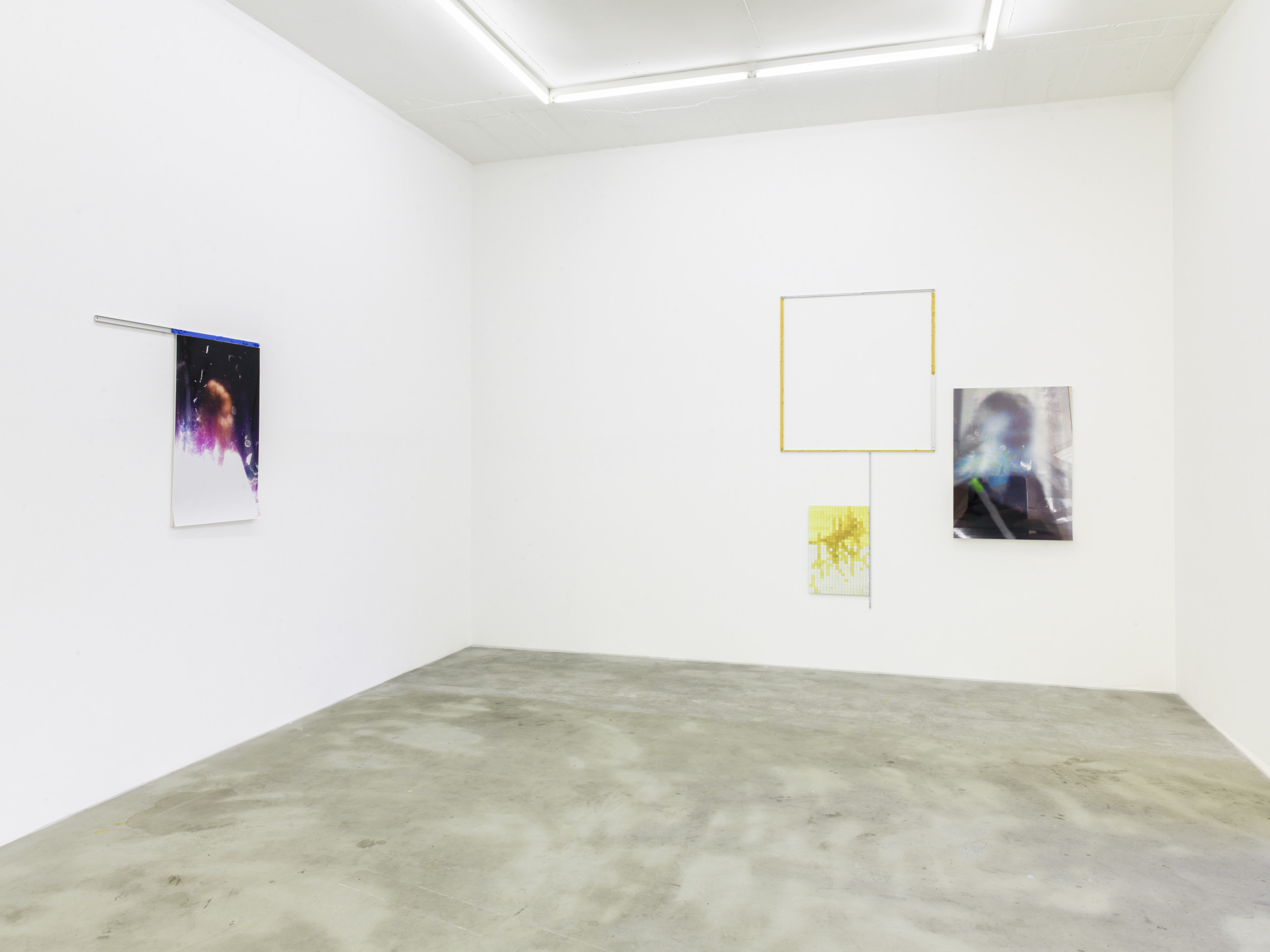Shahin Afrassiabi • Upgrade, Zoom, Beach • 10.09.–29.10.2016
The works in your sketches for your upcoming show Upgrade, Zoom, Beach are pretty much „sketchy” themselves. It is almost like you select objects, for instance frames, but only show a suggestion of these. You seem to shift the focus towards their materiality instead of their actual function. What is the initial point for these works?
I think of them as models. Maybe that is why they appear provisional. Models are subject to change and improvement. I think I am at my best when I improvise. Obviously a certain amount of planning is necessary, but I get better results when I am playing. I need to keep that space open in the studio of course, but also in a show, and once the work is up it is fixed.
Could you say a few words about the exhibition title Upgrade, Zoom, Beach?
The title of the show is a name for each of the three elements on display: the wall constructions, upgraded to aluminium from previous wooden ones, the photographs taken with the zoom function of the camera, and the paintings which are a riff on pixelated satellite images of beaches. These particular words resonate with some aspects of how we experience images that I am interested in; and the conditions in which we experience them.
What sort of conditions do you mean? Are you referring to the circulation of digital imagery?
Yes, but also the methods technology suggests and provides. Images and materials are instruments, like paint is. Paint is both material and instrument. The names are descriptive both of what is going on in the object and in my head. But they also describe a methodology, especially in how the works were conceived – by zooming in on the image, by upgrading the operating system of construction and materials. The beach is the image of presence, of the forever now, where we all want to be, an idyll and for me it has this notion of return to origins.
Just like Marshall McLuhan proposes that a medium itself, not the content it carries, should be the focus of study, the referential characteristics embedded in these materials you use seem to have priority. How do you approach those translational processes, such as switching between mediums, between the texture of photography into painting, between digital and analogue so to say?
The works in the show are really comprised of various aspects of the materialisation of an image, accepting the image as an object and then taking it apart. The gesture, the structure/surface and the support. Those elementary things occur and are repeated in the works. Once the elements are separated they can be re-contextualised. Thinking about it this way frees me up to pursue different manifestations of what an image could be, and what its materiality could be filtered through the application of the methods described above. This way I can avoid the trappings of style.
Why are photography and painting deeply connected to you? And is this self-referential way of using the medium replacing the depiction of specific content or a subject?
Painting and photography have a history of course. This relationship has been disruptive and constructive at different times, but today their singularity is somewhat undermined in an interesting way, I think, or at least the new technologies open up possibilities that weren’t there before. But for me the interest is in where they overlap, which is in the image. In our kind of technological image. This technological production of painting feels very authentic these days, very embedded. This is the way a photograph is produced. One of the effects of the new technologies including photography was regarding the idea of virtuosity where it related to truth. In this new situation, where does value reside? What makes a good image?
The single problem for me was always this idea of the subject matter. This is not a new anxiety. The rejection of literature in visual art has a tradition. Making one thing that tells the story of something else seems inadequate and reductive to me. The way language can be reductive except of course when it is repurposed as poetry, or as technical language. Images and objects are not like language, although they may generate language. That is the idea anyway.
And do the blurry and pixilated, blown-up photographs lay claim to the same idea?
That’s correct. The blur, the pixel and the zoom are also pretty good terms for our current existential dilemmas too. maybe they could be the real subject of the work.
Those aluminium frames are very reminiscent of commercial display devices in public spaces, used for advertisement, for example. You deconstruct them and arrange them differently, in a rather casual way. Can you tell a bit more about these processes of deconstruction?
They are aluminium profiles that could be used for a number of different things, but it is not incorrect to extrapolate ‘frames’. The reference to public as opposed to private space is important. The subject is an affect of social space, and public space is a space of dissimulation, fragmentation and violence as well as art. This is true of the object as well. The two are one and the same in my work. But it’s not really that I want to represent a some sort of ‘reality’ in these works, rather I use particular methods, which are real enough, to make a better image or at least one that doesn’t feel anachronistic.
In terms of public and private dimensions, it is also interesting how you apply imagery of the Google Street View application, for instance. What is it about image stitching that you find interesting or useful?
The machine instance of recompiling images looks very much like a creative act devoid of a subject. With the new work I wanted to focus on this apparently absent subject. You see the flash of the camera catching every mark on the screen, marks made by hands. The camera catches remnants or traces of the physical act of engaging with this technology, the interface, the screen. The image that results from this is not so much a photograph, more a construction, closer to painting even. These marks are then reiterated in the aluminium and silicon constructions, which bear fingerprints and gestures resulting from the handling of the material. The third element in the show, the grid paintings present this mark making again though mediated through a different but related technique. It is a matter of definitions: When is a photograph not a photograph, or a painting not a painting, or a subject not a subject? It is a question of limitations. When does an image become dialectical? I am interested in Walter Benjamin’s idea of the dialectical image. What Benjamin meant by this term remains opaque, although he seems to think it happens in language. I like to think of it as an image of discord and postponed resolution. A layered but non-hierarchical construction. I am trying to make a convincing one. It isn’t a picture.
Your result is rather an acknowledgement of the symbolic potentialities and contingencies embedded in materiality – though in a much more critical way – at the same time being a portrait of the technological present. On the other hand your work seems to be more about the detachment from that very history or context and more about developing new strategies in order to open up the discussion to new possibilities, particularly in regards to digital imagery.
It’s a commonplace to say that art is implicitly critical by its drive towards difference, but yes, however I would put the emphasis not on digital imagery, but on historical manifestations of the image. I am not so much interested in the digital image as I am in the image as such, painting, printing and photography being the history, the digital image being the last iteration of the making and use of images. In fact my interest is in the idea of the subject, and in the object/image standing in a dialectical relation to the subject. This cannot happen if the image is resolved externally as it were, by externally imposed content. That is the reason for the multivalency of the works. Features multiply and migrate from one element to another in an endless suspension of resolution. As for the digital image, its objective qualities are somewhere in the binary code which makes them possible. I am not interested in that or at least not at the moment.
Speaking of the supposed subject – could you talk a bit about your choice of using photographs of women only?
I am glad you ask me this question, no one did before, which puzzles me. I had to make a choice at the outset. I wanted the most banal image. The zero degree image as it were. But one that was capable of complicating this relation of banality and desire. The image of woman in our culture does stand for desire. It is the one that underwrites and activates all commodities as desirable objects. It is both universal and particular.
Also interesting is your series The Dress is a Building (2014/15), digitally printed, delicate and “feminine” silk dresses, which were partly performed through life models in past exhibitions. Here, the aspect of “Display” both, within an exhibition context and in the public realm, gains a completely new meaning.
There is of course the trope of layers or layering. The dresses reiterate what happens in the photographs, the layering of the screen onto the image. The screen as a layer. In the dresses the image is instrumentalised. It is made functional. They, when worn by the model, superimpose the image onto the body. You can see the image, but you can also see the actual body through the transparent silk. A palimpsest. This is another way of doing violence to the image, re-contextualising it, repurposing it, a tautological gesture of redundancy, of the image but perhaps the body too. The tension that comes from this superimposition is interesting to me. I am thinking of Rauschenberg’s white paintings. White on white on white wall, transparency, annihilation.
A conversation between Shahin Afrassiabi and Melissa Canbaz
August 2016








